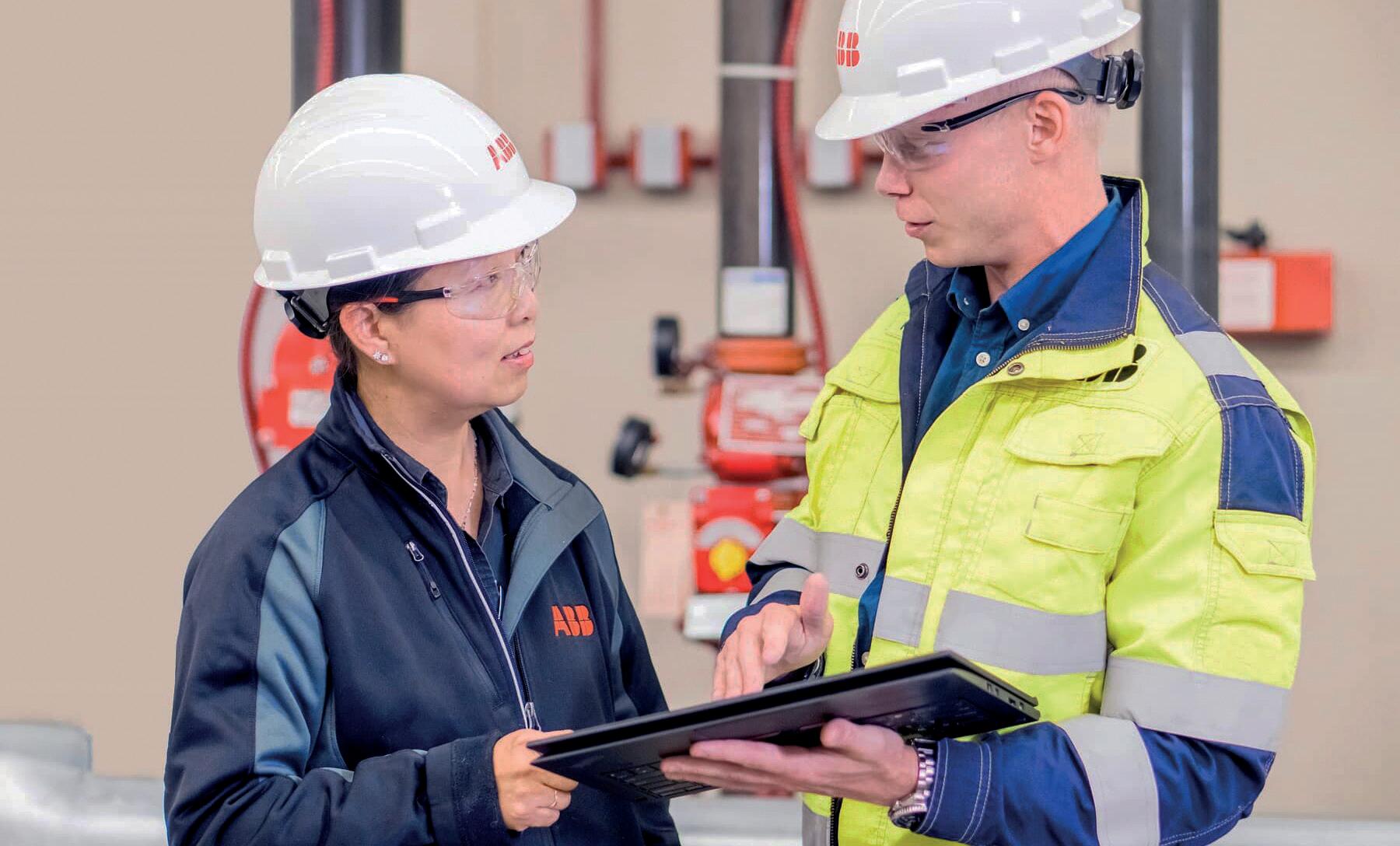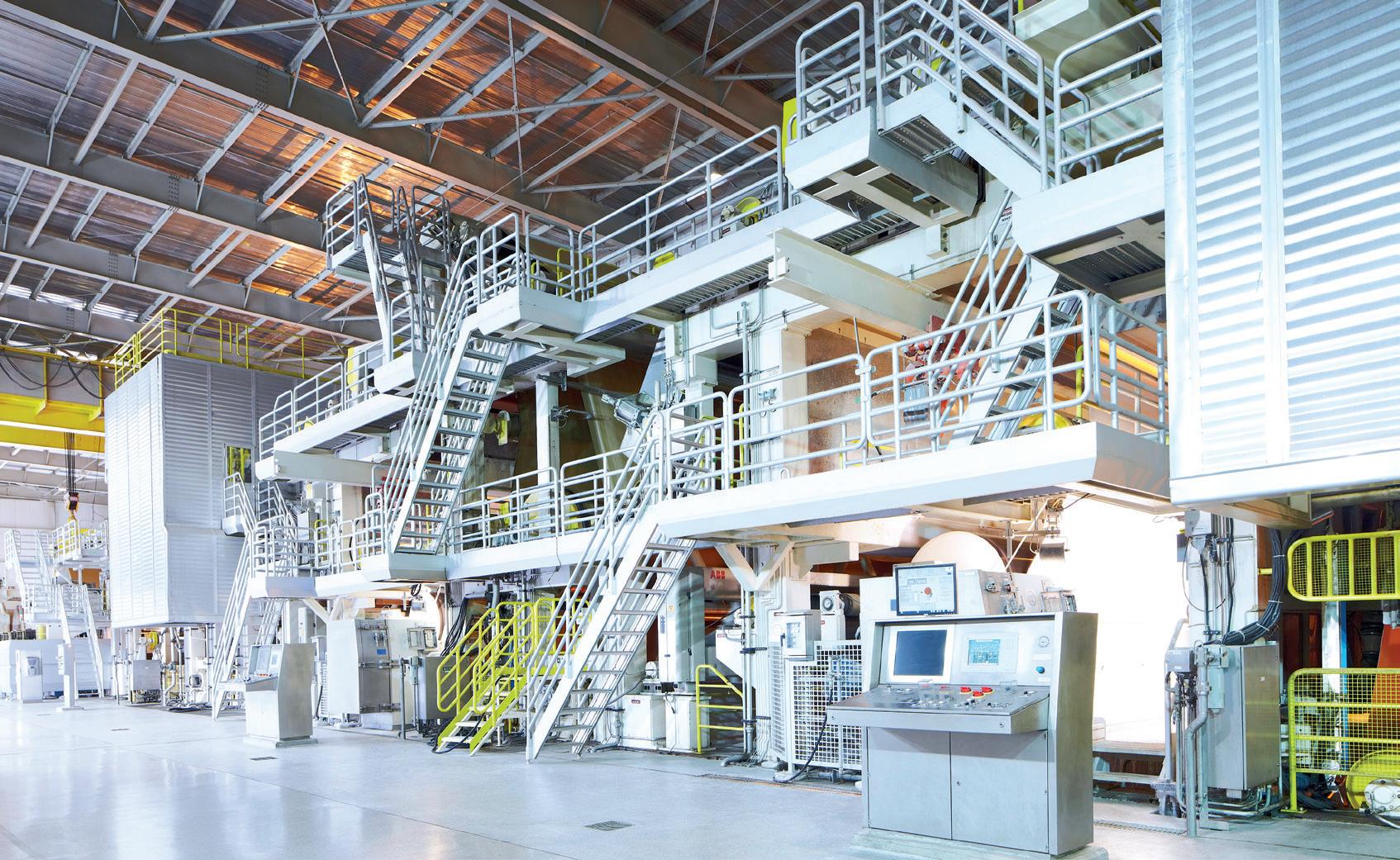
7 minute read
Stay ahead with your digital transformation
To thrive and survive in today’s increasingly competitive and digital industry, smart investment decisions are needed. Lu Athnos* offers advice on how to make them
Digitalisation, Industry 4.0, Industrial Internet of Things: however you want to phrase it, we live in the digital age. But with the many challenges facing pulp and paper mills, not enough mills have been able to move with the times, and some continue to rely on ageing control systems. Legacy equipment and poor maintenance can result in motors and drives breaking more often, in turn creating one of the biggest challenges for papermakers –machine uptime performance – which impacts both profitability and productivity.
Advertisement
Those falling behind are simply doing the basics to keep operating rather than taking full advantage of modern digital systems to remain competitive. Mills need to invest and innovate to stay ahead. If not, it becomes a spiral of failure. Mills don’t invest, productivity decreases, revenues fall, and competitiveness suffers.
While investment is crucial, the reality is that it’s not always readily available. The good news is that it can be carried out in phases and does not have to mean a one-off upgrade at an extortionate cost.
Baby steps approach to mill modernisation
So, what to do? Where to spend?
What to prioritise? A mill’s to-do list is not empty of good ideas.
This depends on where your mill is in its digitalisation process and where you can achieve highest return-on-investment (ROI). Every mill is different, and each has its own priorities based on the spec and volume of its output. However, there are some critical steps that are common to all mills looking to modernise and increase production.
1. Improving mill operations through regular upgrades and incremental enhancements
Continuous, ongoing updates and improvements – taking small systematic steps, one at a time, all leading to the same end goal – will break down the complexity and risk of an infrastructure upgrade while enabling mills to test the success and ROI as they go.
To achieve optimum performance, managers must be relentless about constant, incremental updates, no matter how small. It is critical to be able to see and measure results, yet a small number of mills still don’t even yet have basic online sensor measurements such as weight and moisture, for example. If you can’t measure quality, the consumption of raw materials such as fibre, chemicals and energy is often not optimum for the paper products produced, which affects your efficiency and productivity.
In one case, a central US mill had not invested in new technology for years but wanted to increase throughput by adding a new steambox. However, to handle the increase in available information and measure it more accurately, management realised it would have to upgrade to a newer Quality Control System (QCS). This obsolescence conflict could have been avoided if the mill had kept up with equipment advances through regular upgrades. Examples such as this abound. It is important to understand that the improvements that can be realised are not restricted to any one part of a mill’s processes. From wet end to roll handling, there are numerous opportunities, as shown by the following case histories.
● In Sweden, Holmen Paper Braviken provided an example of how an optimisation project can help to reduce downtime and improve runnability. Operational disruptions were affecting the availability of the mill’s RM3 winder, which produces jumbo rolls of printing papers weighing up to 50 tonnes. The mill opted for ABB’s automation and electrical system, upgrading to ABB Ability System 800xA, which included control and operation of the winder, as well as Winder Performance Optimization, which monitors key performance indicators (KPIs), identifies improvement opportunities and enables the dynamic adjustment of speed to meet capacity for each roll set. This integrated solution drove better runnability, reduced downtime, easier troubleshooting, and increased productivity.
● In Asia, a major paper mill running a complex operation with 13 paper machines needed to maintain high production while being able to correctly predict service costs and constantly improve process performance. They turned to ABB’s remote monitoring and predictive analysis technologies. This helped the mill harness the tremendous amount of data to address production, quality and cost issues – one step at a time – and reduce both the time needed to complete bump tests by 70 per cent and the overall loop tuning effort by 75 per cent. This contributed to increased production, lower chemical costs, accelerated grade changing, fewer sheet breaks, reduced unplanned downtime and machine direction ash variability.
● In Sweden, a tissue mill had planned to install the newest technology on its PM8 measurement platform. On its other paper machines ABB scanners were installed in the 1990s. However, some of the sensor material was radioactive which, as well as degrading over time, also presented safety issues. It was decided to install the ABB High Performance Infrared Weight and Moisture single sensor (HPIR-FW), which replaced two separate weight and moisture units, making for easier maintenance and improved reliability while also removing a source of radiation from the mill.
2. Maintain the discipline of ongoing maintenance
Buying an expensive new home and not taking care of it properly will inevitably lead to costly repairs. As can be seen by the aforementioned case histories, it is the same with a mill’s process control operations. Ongoing maintenance and upkeep are essential, or the benefits of any modern system will be lost.
Too many mills run to failure or adopt an ‘if it isn’t broke, don’t fix it’ mentality. Then, it is not a matter of ‘if’, but ‘when’ equipment will fail. If required maintenance is ignored for too long, damage becomes irreparable.
This was particularly relevant during the pandemic, a challenging time for mill operations that were focused on surviving rather than thriving and had to keep mills running in difficult conditions, while running on empty themselves. It’s not surprising that under such intense pressure, certain disciplines became of a lesser priority. That said, now is the time to restore the discipline of regular, physical inspection and remind ourselves of the importance of the basic, daily maintenance that is so critical to mills.
There are recommended proactive processes, such as Reliability Centered Maintenance (RCM), which takes advantage of a variety of maintenance strategies to optimise all assets in a facility and ensure the most efficient running of a mill. RCM finds the right approach for the right piece of equipment by analysing the criticality of your assets, identifying and prioritising failure modes, and then implementing maintenance planning, asset condition monitoring, predictive and preventive maintenance strategies to avoid equipment failure. This not only reduces maintenance hours and costs but will also decrease unplanned (emergency) repairs.
3. Benefit from a smarter approach to data management
The increasing sophistication and capability of technology means that reams of data become available to operators. So how do you avoid the risk of getting lost in this flood of information?
While the industry is increasingly embracing digitalisation –particularly in terms of an enhanced ability to collect data – knowing how best to utilise it is key. Effective data management requires having a strategy and reliable methods to access, integrate, cleanse, govern, store and model: to prepare data for analytics so that it adds value. Data can only be effective when it is validated. A mill needs to know from the outset what it wants from its control system and accept the veracity of the data it receives.
ABB offers digital services that monitor and set thresholds for performance data variability. If operations go outside the threshold, it triggers an alarm so action can be taken thus preventing failures. And if additional support is needed for troubleshooting, remote connection coupled with data monitoring gives experts the tools to immediately start diagnosing – something that became even more critical when Covid restricted site visits.
Measure, analyse and act – and automate: this is how advanced control systems help a mill optimise operations.
4. Invest in people across generations
With the vast amount of data comes the need to train operators to be able to read and use it
Big investments need to be backed up with data acquisition and management but with that comes the need to train operators to be able to read and use it properly. Humans will not be replaced by artificial intelligence (AI), but they will be replaced by other humans who can use AI properly. Humans will not be replaced by artificial intelligence (AI), but they will be replaced by other humans who can use AI.
The ‘silver tsunami’ is a reality. A lot of papermaking knowledge has been lost in recent years through retirement, with an evident knowledge gap between generations, and paper makers are faced with competition for talent from the other process industries.
However, this is offset by the opportunity that the rise of digitalisation and inclusion of gaming elements in future automation systems designed to harness the talents of Generation Z brings, particularly in the way it is creating new opportunities for the engineers of tomorrow. Most of the new generation of operators entering the workforce don’t yet fully understand the paper making processes but this should not prohibit any mill or system from reaching its potential. The young ‘Nintendo’ generation – sometimes referred to as ‘button pushers’ – is agile and attracted to new technology systems and knows how to leverage them to become better paper makers. Success relies on a combination of paper making process training and understanding and embracing digital systems, so it is critical for mills to continue to bridge the generation gap and increase understanding on both sides of the aisle. Our industry is at the dawn of a new era. It is well placed to shift our recognition of skills and adopt a digital-first approach that will be essential in competing with other industries. We have a unique opportunity to cross-train and combine the best of both worlds; embracing the new, technologically-savvy generation of engineers while maximising and augmenting the skills of process experts who have been serving the industry for years. If we are to raise our profile as an attractive sector in which to build a career, we need to work together to strike the balance between sharing the established knowledge we already have and training up the next generation of talent.
Ensuring a return on your investment
The benefits of investing in and maintaining a modern control system go far beyond a few more tons out of the door. As the mill examples cited have shown, along with improved production comes enhanced and consistent quality, a safer work environment as well as reduced energy and raw material consumption. Operating efficiency increases and critically, improved competitiveness results in a healthier bottom line.
ABB firmly believes that the future of the pulp and paper industry is sustainable – both environmentally and commercially – but to succeed mills need to keep moving the needle forward with a phased approach that also maximises data and talent at hand.
*Lu Athnos is Regional Sales Manager at ABB Pulp & Paper











